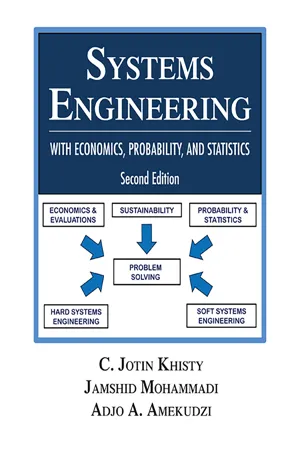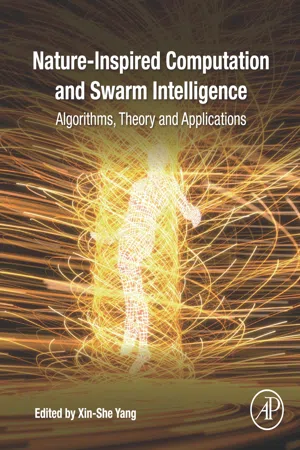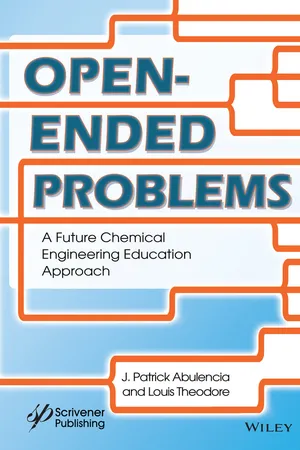Technology & Engineering
Probability Engineering
Probability engineering is the application of probability theory to engineering problems. It involves the use of statistical methods to analyze and design systems that involve uncertainty and variability. The goal is to optimize the performance of systems while minimizing the risk of failure.
Written by Perlego with AI-assistance
Related key terms
3 Key excerpts on "Probability Engineering"
- eBook - ePub
- C. Jotin Khisty, Jamshid Mohammadi, Adjo Amekudzi(Authors)
- 2012(Publication Date)
- J. Ross Publishing(Publisher)
SUMMARY(b) In this part, the probability of concern can be computed using Bayes’ theorem (Eq. 5.39). However, we do not know whether the snow accumulation was heavy or light. Thus we must consider both possibilities in our computation. The required probability is computed through the following series of calculations:In this chapter, the basic rules governing events and equations related to probabilities were reviewed. Probability is a numerical measure that describes the chance of occurrence of a specific event among a number of possibilities. The need to use probability stems from the fact that there is an element of uncertainty involved in any engineering decision-making process as well as in any engineering analysis and design procedure. Essentially, the purpose of analysis and evaluation of engineering data is to provide information for a meaningful estimation of parameters that influence the decision making and system analysis and design. The basic elements of the theory of probability are especially important in understanding the underlying concepts in the evaluation of data and estimation of statistical values of parameters that are involved in engineering problems.The review of events and probability provided in this chapter is brief. Nevertheless, the chapter provides nearly all of the essential equations needed to proceed with solving a given engineering problem. Several examples were provided to better acquaint the reader with the types of problems that an engineer may be facing. For a more complete treatment of the theory of probability as applied to engineering problems, the reader is referred to the list of references at the end of this chapter. These suggested references provide the reader with an ample number of illustrative examples that are useful for better understanding the application of the theory of probability to engineering problems.REFERENCESAng, A. H.-S. and W. H. Tang (2007). Chapter 2 in Probability Concept in Engineering: Emphasis on Applications to Civil and Environmental Engineering - eBook - ePub
Nature-Inspired Computation and Swarm Intelligence
Algorithms, Theory and Applications
- Xin-She Yang(Author)
- 2020(Publication Date)
- Academic Press(Publisher)
Chapter 20Optimization in probabilistic domains: an engineering approach
Panagiotis Tsirikogloua ; Konstantinos Kyprianidisc ; Anestis I. Kalfasd ; Francesco Continob a Limmat Scientific AG, Zurich, Switzerlandb Université Catholique de Louvain, Thermodynamics and Fluid Mechanics Group, Louvain, Belgiumc Mälardalens Högskola, Energy Engineering, Västerås, Swedend Aristotle University, Department of Mechanical Engineering, Thessaloniki, GreeceAbstract
The uncertain nature of engineering variables and parameters dictates the transition of engineering design from global exploration and deterministic optimization to the uncertainty quantification and probabilistic optimization. Therefore, such optimization processes and algorithmic frameworks emerge as key aspects of engineering design, aiming to derive new solutions to all sorts of products and processes. Nature-inspired computing is one of the main drivers, coupled to the continuously evolving engineering models. In this chapter, several aspects of probabilistic optimization are analyzed from an engineering application perspective to highlight the advances and shortcomings as moving towards the efficient global optimization in probabilistic domains. Moreover, the definition of engineering optimization cases, uncertainty quantification techniques, surrogate modeling, and other common case-related challenges are discussed. Finally, this conceptual analysis focuses mainly on engineering models from the aircraft design field, which can provide different types of engineering cases. - eBook - ePub
Open-Ended Problems
A Future Chemical Engineering Education Approach
- James Patrick Abulencia, Louis Theodore(Authors)
- 2015(Publication Date)
- Wiley-Scrivener(Publisher)
statistics as “facts or data of a numerical kind, assembled, classified, and tabulated so as to present significant information about a given subject; the science of assembling, classifying, tabulating, and analyzing such facts or data”. There are obviously many other definitions.The key area of interest to chemical engineers is however, statistics. The problem often encountered is usually related to interpreting limited data and/or information. This can entail any one of several topics.- Obtaining additional data and/or information
- Deciding which data and/or information to use
- Generating a mathematical model (generally an equation) to represent the data and/or information
- Generating information about unknowns, a process often referred to as inference
- Probability Definitions and Interpretations
- Introduction to Probability Distributions
- Discrete and Continuous Probability Distributions
- Contemporary Statistics
- Regression Analysis
- Analysis of Variance
Finally, the reader should note that much of the material in this chapter was adopted from L. Theodore and F. Taylor, “Probability and Statistics,” Theodore Tutorials, East Williston, NY, originally published by USEPA/APTI, RTP, NC, 1993 [2].19.2 Probability Definitions and Interpretations [2,3]
Probabilities are nonnegative numbers associated with the outcomes of so-called random experiments. A random experiment is an experiment whose outcome is uncertain. Examples include throwing a pair of dice, tossing a coin, counting the number of defectives in a sample from a lot of manufactured items, and observing the time to failure of a tube in a heat exchanger or a seal in a pump or a bus section in an electrostatic precipitator. The set of possible outcomes of a random experiment is called the sample space and is usually designated by S. Then P(A), the probability of an event A, is the sum of the probabilities assigned to the outcomes constituting the subset A of the space S. A population is a collection of objects having observable or measureable characteristics defined as a variate while a sample
Index pages curate the most relevant extracts from our library of academic textbooks. They’ve been created using an in-house natural language model (NLM), each adding context and meaning to key research topics.


